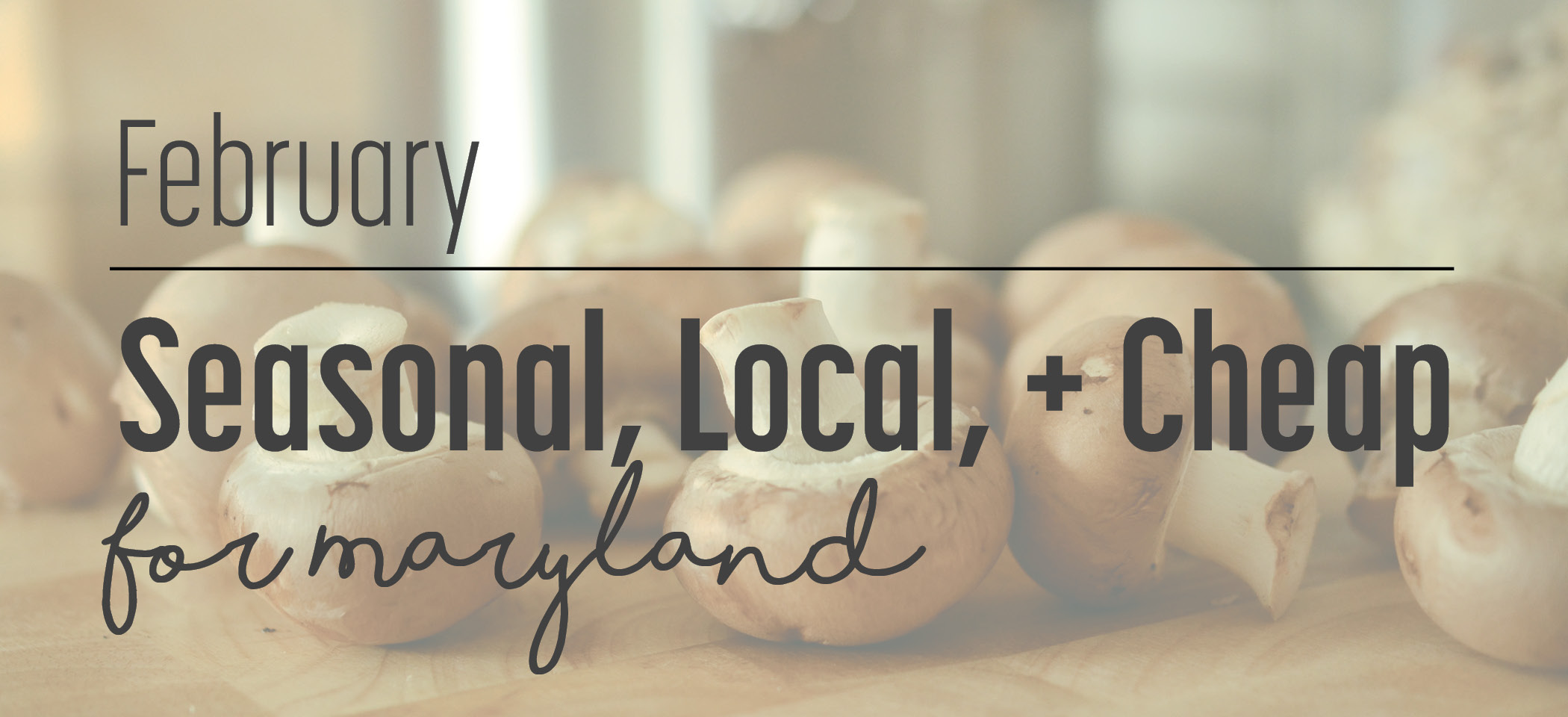February
It starts to look bleak this time of year—I won’t lie. When you have a look at the seasonal chart, it won’t look too optimistic, sure. But keep in mind that the chart is limited to the very small state of Maryland and that the surrounding region can provide you with further variety. (Also, one word: avocados.) Additionally, you can supplement produce that’s in season with dried goods, canned/jarred foods, grains, and food you’ve frozen. And don’t forget about all the delicious winter recipes you can prepare! That’s something to be truly excited about!

In Season, but Not Necessarily Local:
Particularly in these colder months, eating seasonal and local might offer slim-pickings. Now, you could stick exclusively to root vegetables, but don’t beat yourself up if you want to expand your palate. You can still feel good eating these not-necessarily-Maryland, but nevertheless in-season foods:
Vegetables:
- Arugula
- Asparagus
- Beets
- Bok choy
- Broccoli
- Broccoli rabe
- Brussels sprouts
- Cabbage
- Cardoons
- Carrots
- Cauliflower
- Celery*
- Chard
- Chicory
- Collard greens
- Cress
- Dandelion greens
- Endive
- Fennel
- Garlic
- Green garlic
- Herbs
- Horseradish
- Kale
- Kohlrabi
- Lambsquarters
- Leeks
- Lettuce
- Mizuna
- Mushrooms
- Mustard greens
- Nettles
- Onions
- Orach
- Parsnips
- Pea shoots
- Potatoes*
- Radishes
- Rutabagas
- Scallions
- Shallots*
- Spinach
- Sprouts
- Squash, winter*
- Sunchokes
- Sweet potatoes*
- Taro root
- Tatsoi
- Turnips
Fruits/Nuts/Seeds:
- Almonds*
- Apples*
- Asian Pears*
- Avocados
- Cherimoyas
- Dates*
- Grapefruit
- Guavas
- Kiwi*
- Kumquats
- Lemons
- Limes
- Mandarins
- Oranges
- Pears*
- Pecans*
- Persimmons*
- Pistachios*
- Pomelos
- Walnuts*
*Can be found at the market, but not within its natural growing season.
Where to Buy
Now, you may be wondering how you can buy local in the winter. Don’t farmers markets close at the end of the warmer months? Not necessarily! While some markets will close up shop in the fall, there are plenty that remain open throughout the year. Have a look at the Maryland Winter’s Farmers Market Guide from the Maryland Department of Agriculture. One of our favorite Baltimore markets is the year-round 32nd Street Farmers Market in Waverly!
Additionally, it’s not uncommon for grocery stores, particularly health food stores, to carry and label produce grown locally (typically, ‘local’ to a grocer includes a multi-state region—at least it does from our experience in Maryland). And remember, buying food while it’s in season can be a lot cheaper! You might also be surprised to find out that wholesale stores (e.g., BJs, Costco, or SAM’s Club, etc.) will shift their stock depending on the season! (Bulk kale? Kale yeah!)
CSAs
For the Seasonal, Local, Cheap series, we’re also partnering with (vegan) farmer Emma Jagoz from Moon Valley Farm in Baltimore County. She’s providing some great information about local food. And you’ll be happy to know that sign-up for the 2017 season community supported agriculture (CSA) share from Moon Valley is open! There are a number of share types (so you can select one to suit your needs) as well as various pick-up locations (so you can find one that’s conveniently located). So, you can either pay online via PayPal, or pay by check along with this completed Member Agreement Form and mailing it to:
Moon Valley Farm, 1124 Greenway Road, Cockeysville, MD 21030
Pairing Tips
Eating seasonally can be quite rewarding, but once you allow yourself to perceive it as limiting you might find yourself hitting road blocks. You can complement seasonal foods with grains, pastas, breads, dried goods, canned goods, and jarred foods, or with frozen foods as well. We highly recommend saving money by purchasing these goods in bulk, or preserving and storing foods from earlier seasons yourself. Buying in bulk might be especially valuable this time of year, to avoid last minute trips to the grocer before impending snow storms. And of course season your food with dried spices and sauces you’ve either purchased or made throughout the year!

Suggested Recipes
So what are some scrumptious meals you can prepare this February to keep you warm and cozy? We’ve selected a handful of recipes you might want to try. Most or all of the ingredients are typically in-season this time of year, with the occasional out-of-season addition. We encourage you to play around with the recipes yourself, and if you think you can make it 100% local and 100% in-season, we would love to see what you cook up! Here are some ideas:
- Kale, Lentil, & Roasted Beet Salad | The Minimalist Baker
- Vegan Cream of Asparagus Soup | The Blender Girl
- Vegetarian Southern Collard Greens | Divas Can Cook
- Pasta with Roasted Endive & Brussels Sprouts | Delightful-Delicious-Delovely
- One Bowl Vegan Orange Cake | Vegan Richa
Resources:
- Moon Valley Farm (Maryland CSA)
- Seasonal Foods Guide
- Cookie + Kate January Produce Guide
- CUESA Seasonality Chart – Vegetables
- CUESA Seasonality Chart – Fruit
- Calendar of Maryland Harvests
- Pick Your Own | Maryland Harvest Calendar
- Maryland Seasonal Fruits & Vegetables
- Maryland Fruit and Vegetable Seasonality Chart



